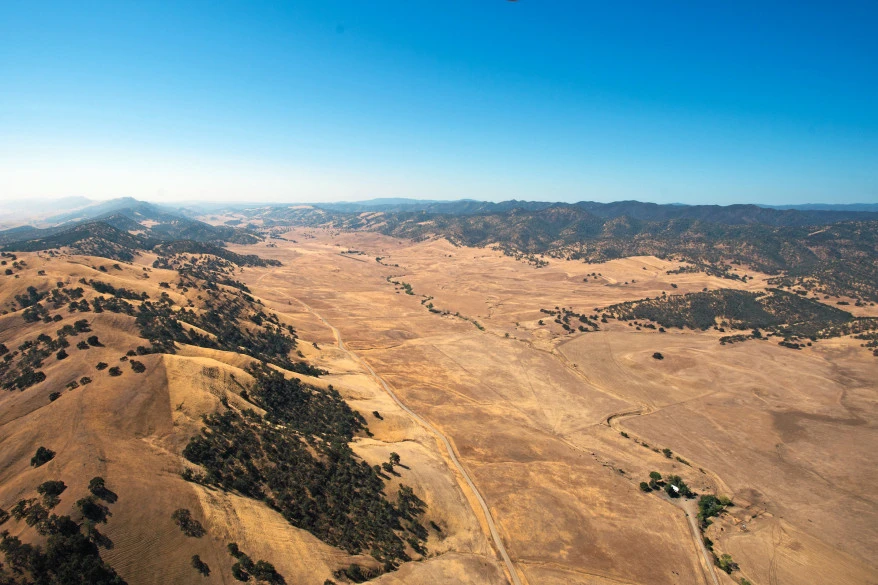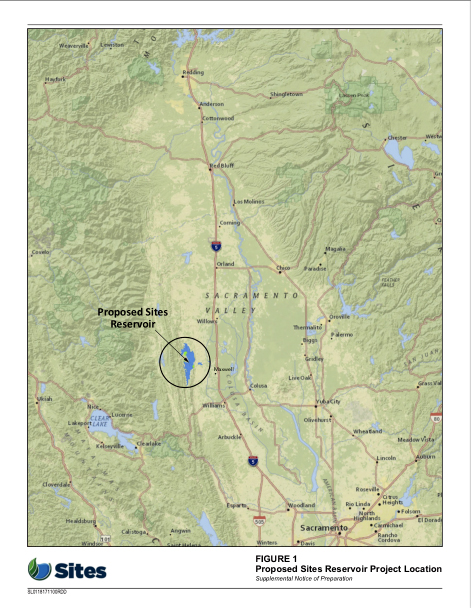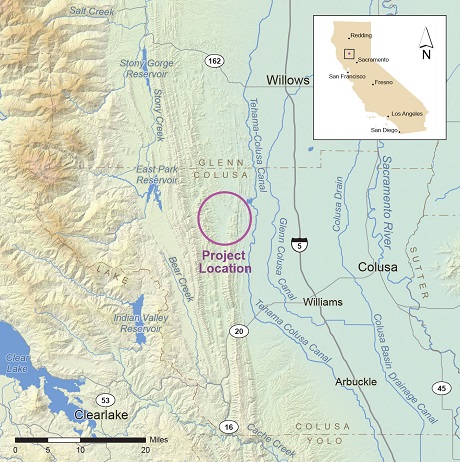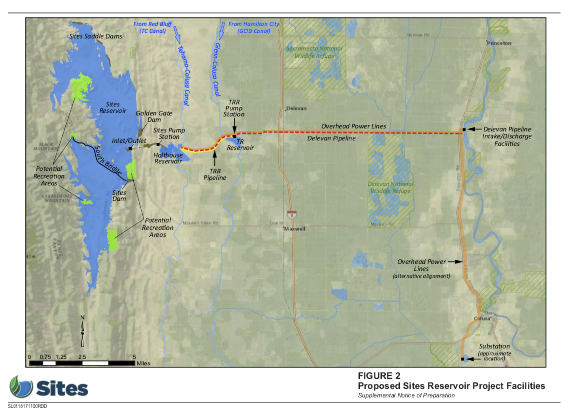
Aerial view of the future SITES reservoir location.
Photo credit: Maxwell. Kelly M. Grow — California Department of Water Resources
The Proposed SITES Reservoir



The Sacramento River is the largest river in California and is the main source for the largest estuary on the west coast of the Americas, an ecosystem that is already seriously affected by historically reduced water flows.
Highlights
- 1.8 million acre-foot off-stream storage reservoir on the west side of the Sacramento Valley outside the city of Maxwell.
- Potential annual yield = 500,000 acre-feet*.
- Up to 8 dams would be required with a construction cost estimate of $4.4 – $6.6 billion.
- Purports to use “excess” water in winter seasons yet offers inadequate safeguards to limit timing and amount of diversions to levels safe for the fragile Sacramento River and Delta ecosystems.
What is the proposed SITES project?
The SITES proposal is advertised as “shovel ready” and is being fast-tracked however it has still not gone though the full review process required under CEQA (California Environmental Quality Act). The Bureau of Reclamation’s SITES DEIR/DEIS uses outdated data, flawed projections and fails to address numerous impacts and alternatives required by CEQA and NEPA. The DEIS/DEIR has violated the Fish and Wildlife Coordination Act (“FWCA”) which requires that the Bureau of Reclamation consult with and fully consider recommendations from the U.S. Fish and Wildlife Service (“FWS”), National Marine Fisheries Service (“NMFS”), and California Department of Fish & Wildlife (CDFW) regarding potential project alternatives and mitigation measures. The BOR’s DEIS/DEIR fails to include their mandatory FWCA report which must document that those steps were taken.
The DEIS/DEIR contains substantial flaws and inaccuracies, fails to disclose significant impacts, and fails to consider reasonable mitigation measures. It should be revised to address these issues and recirculated for public comment.
- Many environmental organizations and governmental agencies are opposed to the project and it is certain to face years of legal challenges should it move forward. Instead, time and money could be spent on real, supportable solutions.
- No Feasibility Report has yet been done to answer questions about reservoir operations, cost, amount of reliable water supply, specific beneficiaries, etc.
- If constructed, SITES would be privately owned and operated. Yet they are asking to be given $1 billion or more in public taxpayer funds.
- The SITES concept has been ruled out many times in the last 20 years because the MEASURABLE COSTS were HIGHER THAN THE ASSUMED BENEFITS. A large part of the project’s allure is huge profits for water districts. As just one example, the Glenn – Colusa Irrigation District’s (GCID) proposed share of SITES water would be 20,000 acre feet annually which they could sell on the open market. At a typical cost last year of $1,000 per acre-foot, GCID’s take would be $20 million dollars. Their windfall would come at a great cost to the Sacramento River, the Bay Delta estuary system and other impacted geography and wildlife.
- At times, this project could potentially take 50% of the water out of the Sacramento River south of Colusa. Adequate river flow and flushing flows for the delta are essential to sustain habitat for dependent aquatic and terrestrial species.
- There are no adequate or ironclad safeguards for preventing the SITES project owners from diverting water in amounts unsafe to the environment.
- Potential significant impacts to endangered and threatened species: Sacramento River Chinook salmon, Bank Swallows, Valley Elderberry Longhorn Beatles, Yellow-billed cuckoos, Amsinckia lunaris, Golden eagles, and others.
- Loss of investment related to already acquired and restored public lands along the main stem of the Sacramento River: USFWS Sacramento River National Wildlife Refuge, BLM’s Bend Area, and many others.
- Potential increased groundwater use from replacing surface water diverted to SITES.
- Does not provide adequate public benefit for public dollars that may be spent on the project.
- The proponents’ water yield figures for SITES are fundamentally flawed, having not factored in evaporation from such a large reservoir surface, drought, and continued impacts from Climate Change.
- * SITES proponents project an annual yield of 500,000 acre-feet of water (in itself an incorrect figure) at a maximum reservoir capacity of 1.8 million-acre feet. However, California municipal customers saved over 600,000 acre-feet of water in less than three months in the drought through conservation.
SITES is marketed as a “no-brainer” project, but there are many clear reasons why it hasn’t already been built in the decades since it was first proposed
Better solutions are available for less money and environmental cost:
- Follow the directives within the new Central Valley Flood Plan update of 2017 and in the Conservation Strategy to INCREASE the implementation of SETBACK LEVEES – creating habitat, reducing flood risk and STORING WATER in designated floodplains.
- Spend this money instead on NEW DATA COLLECTION and MODELING tools to identify more real solutions.
- Repair old and failing infrastructure to recover lost capacity.
- Invest in improving the San Luis Reservoir so that it is safer and can hold more water south of the Delta.
For more information please visit:
- Friends of the River
- Sierra Club
- Natural Resources Defense Council
- The Bay Institute
- Center for Biological Diversity
- Defenders of Wildlife
- Pacific Coast Federation of Fishermen’s Associations
- Institute for Fisheries Resources
- Golden Gate Salmon Association
Contact your state and federal representatives and ask them how they reconcile their support for this project considering the above facts.
This fact sheet was developed from public comment submitted by the above organizations.
SEA: Shasta Environmental Alliance www.ecoshasta.org